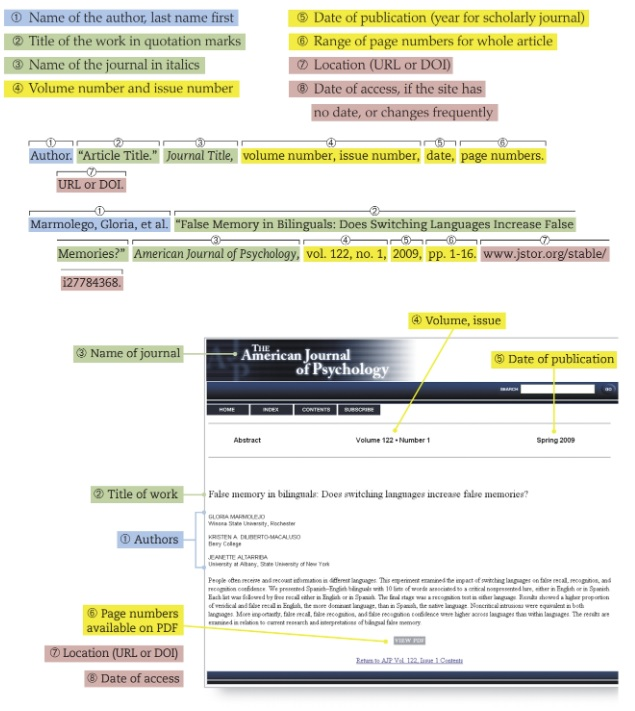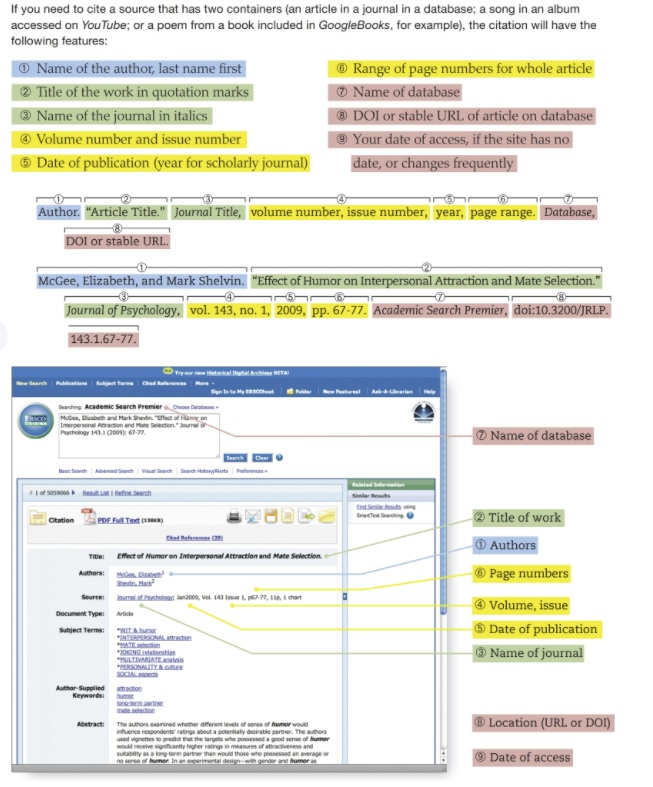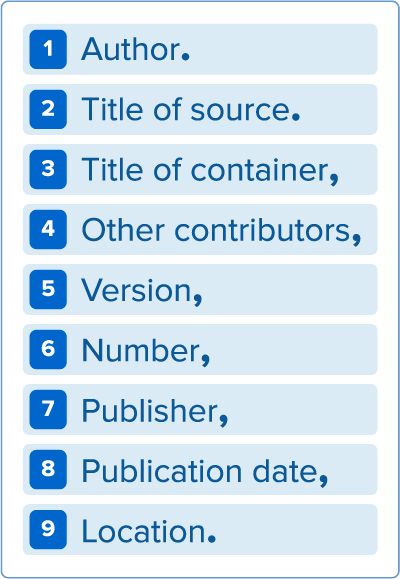32
By the end of this chapter, you will be able to:
- Create bibliographic entries for a works-cited list. (GEO 2; SLO 2)
Citations include all the necessary information about sources that you cite in your essay. They are all listed together on the Works Cited page.
Guiding Principles for MLA-Style Citations

Cite simple traits shared by most works. The traits common to most works – authors, titles, dates of origin – should be included in every applicable citation in the same order.
There is often more than one correct way to document a source. For example, whether you include the title, director, or an actor’s name first in a citation for a film might depend on whether you were looking at the film as a whole, the creation of the film, or a specific performance in it.
Make your documentation useful to readers. The point of providing documentation is to give credit to original sources, so it’s important that your readers can locate them in order to draw their own conclusions about the argument, analysis, or point you presented.
Core Elements of Citations
1. Author.
Present the author’s last name first, then their first name, with a comma between. If there are multiple authors, include all their names in the order they appear, but only the first author’s name should be in the reverse order. Completely spell out the names of corporate authors.
2. “Title of Source.”
This should be the name of the article, entry, chapter, Web page, song, scene, or episode you are using. These types of titles (works that are part of a larger unit) should be written in quotation marks. When you are using an entire unit – such as a book or a film – in your essay, you can skip this.
3. Title of Container,
The container is the larger work that your source in #2 came from, such as the periodical, encyclopedia, book, Web site, album, film, or series. These types of titles should be written in italics. Sometimes, you will use sources with two containers, such as print book that you read online, an article from a journal that you accessed with a database, or a film or TV show that you watched through a streaming service.
4. Other Contributors,
If your source has other contributors, then you will need to write “edited, translated, interview, illustrated, narrated, adapted, produced, directed, adapted, or performance by” then the person’s first and last name.
5. Version,
If you are using a source with specific versions, such a revised edition of a classic work, a version of the Bible, or an extended or director’s cut edition of a movie, you will need to designate in your citation.
6. Number,
Some sources have volumenumbers (such as encyclopedias), issuenumbers (such as magazines), or both (such as journals).
7. Publisher,
The publisher is the entity primarily responsible for producing the source and making it available to the public. For example, books are published by publishing houses, periodicals are published by media companies, movies are published by production companies, TV shows are published by TV channels, and Web sites are published by whomever owns their copyright.
8. Publication Date,
When you are using a book or film, you only need to put the year of publication. Articles and TV shows, however, require the day, month, and year of their original publication. For Web pages, put as much information about the date as it gives you, even if it’s just a year.
9. Location.
For books and other print sources, the location is the page (p. #) or pages (pp. #). For Web sites, the location is the URL Web address. When you do include a URL, you may need to include the date you accessed it as well.
10. Other Elements
If your source comes from the Web, then after you finish the citation, you should write the word “Accessed” and the date you accessed it. Some less common sources, like classic literature, artwork, graphics, oral presentations, court cases, and bills or laws also require additional elements.

Examples:
1. Authors
Lum, P. Andrea. “Computed Tomography.” World Book,Yale University Press, 2000, pp.
193-220.
Gillespie, Paula, Naomi Baron, and Neal Lerner. “Safe Spaces.” The Allyn and Bacon
Guide to PeerTutoring, Allyn, 2000, p. 129.
British Monetary Fund. “Positive Examples of McDonald’s Commercialization in Asia.”
In Defense ofGlobalization, Oxford Press, 2004, pp. 60-62.
2. Articles and Web pages
Maumill, Sarah. “The Great Debate.” CNN Politics, Cable News Network, 13 July 2009,
http://www.cnn.com/politics/the-great-debate/18095.html. Accessed 12 Jan.
2010.
Tanner, Randi. “Patent Pamphleteer.” Scientific American, American Science Academy,
Dec. 2001, http://thescientificamerican.org/Dec-2001/patent-phamp/. Accessed
12 Jan. 2010.
Torres, Vicky. “Watching the Fire.” The Sable Archives, 12 Jan. 2010,
http://www.thesablearchives.com/watchingthefire/. Accessed 16 Jan. 2010.
“History of Alexander the Great.” Histology,
http://www.histology.org/emperors/alexander. Accessed 12 Jan. 2010.
3. Videos, TV shows, and Films
Tyson, Neil deGrasse. “Hiding in the Light.” YouTube, uploaded by Cosmos: A
Space Odyssey, 6 April 2014,https://www.youtube.com/watch?v=
EfcKYQoIDgw. Accessed 16 July 2013.
“The Blessing Way.” The X-Files, created by Chris Carter, performances by David
Duchovny and Gillian Anderson, season 3, episode 1, Fox, 22 Sept. 1995.
Pride and Prejudice, directed by Andrew Davies, performances by Keira Knightley
and Matthew Macfadyen, Focus Features, 2007.
The Usual Suspects, directed by Bryan Singer, performance by Kevin Spacey, Polygram,
1995. Netflix, https://www.netflix.com/ %2Fbrowse. Accessed 20 Nov. 2012.
4. Databases
Bronte, Anne. “Mementos.”Poems by Currer, Ellis, and Acton Bell, London, 1846, pp. 4-
6. Google Books, https://books.google.com/books?id=AnEc5-zIoB8C.
Accessed 18 Sept 2009.
Haber, Joel. “A Cyberbullying Protection Plan.” Time Magazine, vol. 25, no. 4, March
2011,pp. 32-37. Issues and Controversies, doi: 38903457-34580949305.
Accessed 6 June 2011.
La Faye, Dierdre.“Culture and Context.” How to Write About Jane Austen, edited by
Harold Bloom, Random House, 1984, pp.69-88. Bloom’s Literary eBook
Collection, http://0-ebooks.infobaselearning.com.libcat.sanjac.edu/View.aspx
?ISBN=9781438112671&InstID=4036.Accessed 20 June 2009.
5. Contributors
Mitchell, Joseph. “The Bottom of the Harbor.”American Sea Writing, edited by John
Williams,Library of America, 2000, pp. 584-608.
6. Versions and Numbers
The Bible, Authorized King James Version, Oxford University Press, 1998.
Welleck, Renee. “Marxist Theory.” A History of ModernCriticism,vol. 5, Yale University
Press, 1986, pp. 625-628.
Stafford, Rhonda. “Catching the Wave.” The DailyStandard Celina CA, no. 26, Cox
Media,Nov. 2008.
Kafka, Ben. “Redefining Reading: The Impact of Digital Communications Media.” PMLA,
vol. 128, no. 1, Jan. 2013, pp. 193-200.
Citing multiple-container sources

Here’s where things become a little more complicated. Sometimes, a source will appear in a first container that is then included in a second container. For example, let’s say you want to cite an essay that originally appeared in a book (first container) but which you accessed from an online database (a second container). This source has two containers. The information would be cited like this:
Author(s). “Title of Source.” Title of First Container, Other Contributors, Version, Number, Publisher, Publication Date, Location. Title of Second Container, Location. Accessed date.
To help you see how this second container works, here is an example of the same essay that was found in print and through an online source.
Ellison, Ralph. “The World and the Jug.” The Collected Essays of Ralph Ellison, edited
by John Callahan, Modern Library, 2003, pp. 155–88.
Ellison, Ralph. “The World and the Jug.”The Collected Essays of Ralph Ellison,edited by
John Callahan, Modern Library, 2003, pp. 155–88. Google Books,
books.google.com/books?id=GT3oSgZKvQoC&printsec=frontcover&dq=
collected+essays&hl=en&sa=X&ved=0ahUKEwiBmJjQz6LMAhWis4MK
HcMzCNEQ6AEIMTAD#v=onepage&q= collected%20essays&f=false.
Accessed 26 June 2020.


Practice


A reference to a source used in a scholarly work that contains the relevant information about that source's publication.
In MLA Style, the bibliography (list of sources used) is referred to as the Works Cited page.
The creator of a work.
The name of a source. In MLA Style, titles are written in upcase, capitalizing the first letter of each word.
The larger work that contains a source.
A person, other than the author, that contributed to a work's creation or publication.
The different forms of a source that may exist.
1. A work that forms part of a series, such as an encyclopedia.
2. A number accounting for the years a publication has been in circulation.
The individual editions of a publication, such as a newspaper or magazine.
The entity primarily responsible for producing the source and making it available to the public.
